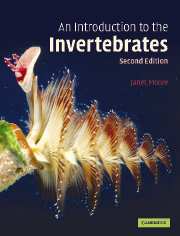Book contents
- Frontmatter
- Contents
- List of boxes
- Preface
- Acknowledgements
- Illustration acknowledgements
- Chapter 1 The process of evolution: natural selection
- Chapter 2 The pattern of evolution: methods of investigation
- Chapter 3 Porifera
- Chapter 4 Cnidaria
- Chapter 5 On being a worm
- Chapter 6 Platyhelminthes and Acoelomorpha
- Chapter 7 Nemertea
- Chapter 8 Nematoda
- Chapter 9 Annelida
- Chapter 10 Mollusca: general and Gastropoda
- Chapter 11 Mollusca: Bivalvia and Cephalopoda
- Chapter 12 Arthropoda: general
- Chapter 13 Crustacea
- Chapter 14 Chelicerata and Myriapoda
- Chapter 15 Insecta
- Chapter 16 Animals with lophophores
- Chapter 17 Echinodermata
- Chapter 18 Invertebrate Chordata and Hemichordata
- Chapter 19 Development
- Chapter 20 Invertebrate evolutionary history
- Further reading
- Glossary
- Index
Chapter 4 - Cnidaria
Published online by Cambridge University Press: 05 September 2012
- Frontmatter
- Contents
- List of boxes
- Preface
- Acknowledgements
- Illustration acknowledgements
- Chapter 1 The process of evolution: natural selection
- Chapter 2 The pattern of evolution: methods of investigation
- Chapter 3 Porifera
- Chapter 4 Cnidaria
- Chapter 5 On being a worm
- Chapter 6 Platyhelminthes and Acoelomorpha
- Chapter 7 Nemertea
- Chapter 8 Nematoda
- Chapter 9 Annelida
- Chapter 10 Mollusca: general and Gastropoda
- Chapter 11 Mollusca: Bivalvia and Cephalopoda
- Chapter 12 Arthropoda: general
- Chapter 13 Crustacea
- Chapter 14 Chelicerata and Myriapoda
- Chapter 15 Insecta
- Chapter 16 Animals with lophophores
- Chapter 17 Echinodermata
- Chapter 18 Invertebrate Chordata and Hemichordata
- Chapter 19 Development
- Chapter 20 Invertebrate evolutionary history
- Further reading
- Glossary
- Index
Summary
Cnidaria include the anemones, corals, jellyfish and hydroids, i.e. all the animals formerly included with the comb jellies (‘Ctenophora’) in the phylum Coelenterata. They may be in the form of sessile polyps, or freely floating medusae (Figure 4.1a,b). All are aquatic, nearly all are marine, and they are very simple in structure. Yet there are vast numbers of individuals belonging to at least 10 000 species widely dispersed in the sea, varying in size from individuals a few millimetres across to coral colonies measuring hundreds of metres. Stinging cells (called ‘cnidae’ or ‘nematocysts’) are used for food capture and defence; they are unique to the phylum and diagnostic of it.
The combination of simplicity of structure with large numbers and considerable diversity provides the theme for this introduction to the phylum. Discussion is focused on how such simple animals can make a living and what features have enabled them to become so diverse. This chapter is relatively rather full, because the emerging picture forms an important background to the consideration of more elaborate animals.
Why do we regard Cnidaria as simple?
They have no head end. The mouth (which serves also as the anus) is the single opening of the only internal cavity, called the ‘coelenteron’, which is an enclosed part of the water in which the animal lives. The mouth is usually surrounded by tentacles where the stinging cells are concentrated.
- Type
- Chapter
- Information
- An Introduction to the Invertebrates , pp. 32 - 46Publisher: Cambridge University PressPrint publication year: 2006



